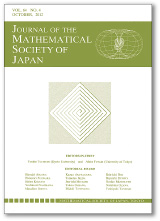Hiroko Shimokoshi
(JMSJ Editorial Assistant, Mathematical Society of Japan)
● Past

In January 2005, I was walking up the road leading to Tohoku University. Both sides of the road were covered with snow. I was going to attend an open forum on digital publishing and digital libraries held at the university. The presentation was done by two staff members from Cornell University. The main topic was a new digital publishing system to cope with looming challenges including rising subscription fees for scholarly journals due to the fact that commercial publishers had taken control of academic publications around the world, which prevented researchers from accessing materials they need. The traditional publishing system was gradually losing its validity since more and more journals had been digitized. A lack of storage space for journal collections became a big issue in libraries. Also, calls for open access of journals were increasing. The speakers also enthusiastically introduced ideas for a world-digital-mathematics library and retro-digitalization, which would allow all the academic heritage that had been built up by generations to be linked each other and accessible for anyone in the world, because basic study of mathematical science is the foundation of all kinds of scientific study and technology including physics and economics. To me, this forum was the first step to learn the concept of digital publication, digital libraries and e-journals. I still clearly remember all the stories sounded like dreams. Since then, eight years has passed and the environment surrounding scholarly journals has drastically changed. Now, there are various services available such as DOI, CrossCheck, CLOCKSS, ORCID, MathJax, and more.
● As one of the SPARC Japan Partner Journals
In November 2005, the Journal of the Mathematical Society of Japan (JMSJ), the official journal published by the Mathematical Society of Japan, was designated as one of the SPARC Japan partner journals and JMSJ started on its path to be digitized. We made newly published articles available on the Project Euclid platform. Meanwhile, for digitizing the archive articles, we asked a vast number of authors to sign a copyright agreement, and gradually uploaded their articles. In the meantime, we completely renewed the JMSJ website and added an e-mail address for submission on the new site. As a result, the number of submission has doubled and so did the impact factor (IF). It has increased from 0.317 in 2000 to 0.63 in 2011 (In mathematics, IF of top journals ranges two or three). The traffic was slightly more than 6,000 hits in the entire year of 2007, when we started compiling statistics. Currently the number of website visits is more than 9,000 per month. Personally speaking, the knowledge and information I learned from SPARC seminars is very valuable to me. I also extended my network and it turned out to be an irreplaceable asset.
● Future challenges
Not only digital publishing but also cross-links among articles as well as digital libraries—things I thought as dreams in 2005—are taken for granted today. However, there are challenges on the horizon. First, we have yet to establish a solid business model. Unlike medicine, chemistry, and physics, mathematics is not directly related to patents or the business community. Therefore, articles in Mathematics are suitable for open access publishing but free open access means that we need to secure funds to publish the journal. Charging a submission fee or publication fee is one of the options but they do not fit in the culture of mathematicians. Currently, we are using a delayed-open-access subscription model and making all the articles available for free after three years of publication. Another issue is that we are not quite sure if our subscription fee is appropriate. The biggest challenge is how to increase JMSJ visibility and presence in tough competition of the global market, as full-open-access articles are published one after another with the advent of mega journals. Above all, the fundamental problem is that renowned Japanese researchers who are at the forefront of their fields in the world tend to be reluctant to submit their papers to a journal published by their own society. This is a common problem shared with all academic societies in Japan.
Given the fast-moving development over the past eight years, the environment surrounding scholarly journals will change even more drastically during the next 10 years. I am looking forward to it but am somewhat afraid of the dizzying pace of shifts and what will happen in the coming years. |

